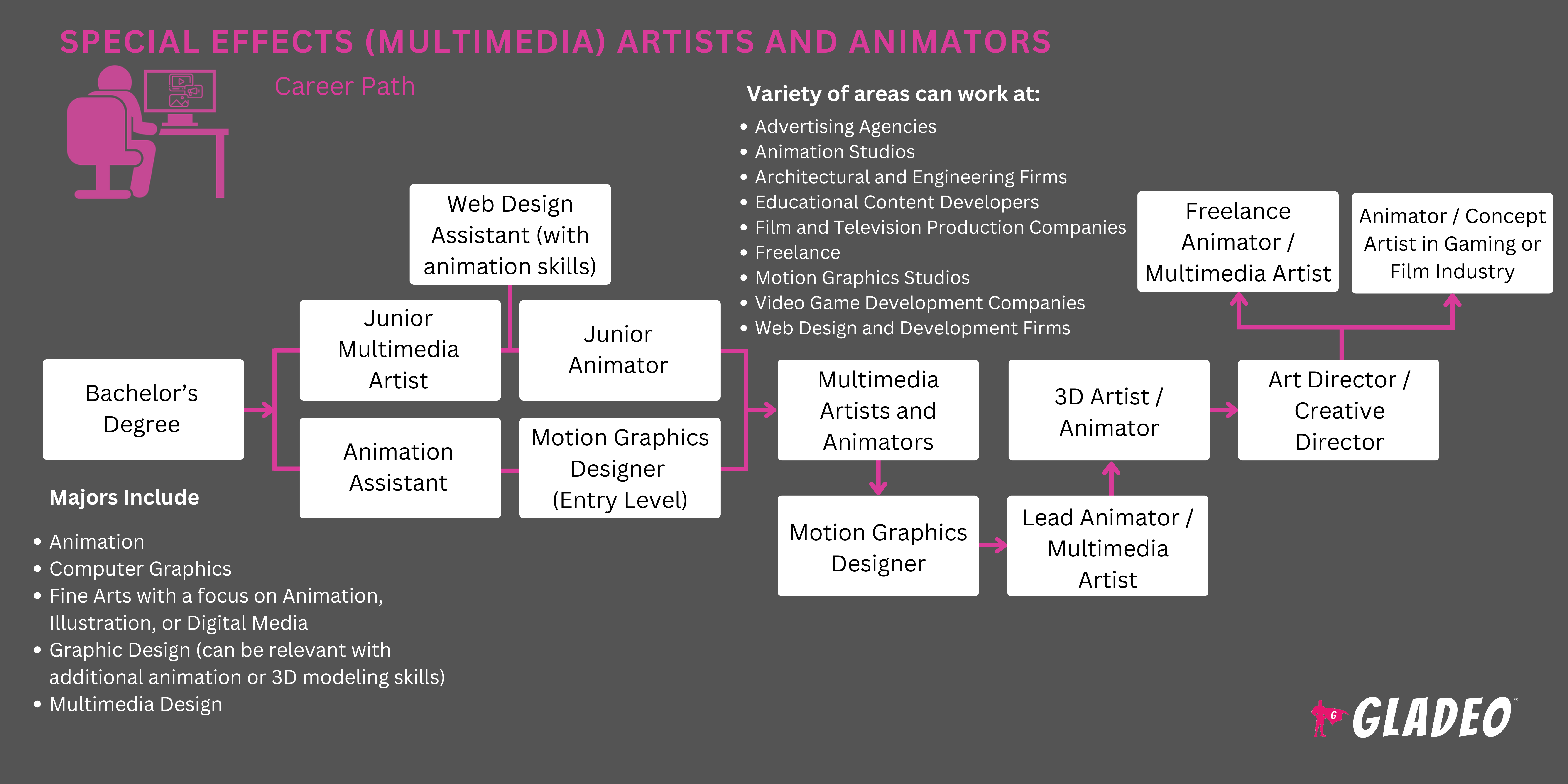Spotlights
Also known as 3D Animators, Digital Artists, Illustrators, Multimedia Producers, Animator; Computer-Designed Parts
We’ve all watched animated shows or movies that feature breathtaking visual effects (VFX) using computer-generated imagery (CGI). This incredible work is done by talented multimedia artists, also known as Special Effects Artists and Animators!
Special Effects Artists and Animators work closely with directors, producers, and other creative professionals to develop and implement visual effects to enhance storytelling. Their work brings imaginative characters and worlds to life in films, television shows, commercials, and video game studios.
The job requires a special combination of artistic and technological skills to design, render, and composite realistic or fantastical elements, often integrating them seamlessly into live-action footage. This dynamic field is changing rapidly thanks to the increased use of sophisticated AI tools, requiring artists to stay flexible and committed to continuous learning.
- Bringing imaginative concepts to life in games, shows, and movies
- Opportunities to work with cutting-edge technology
- Collaborating with creative teams on high-profile projects
- Seeing your work enjoyed by global audiences
Lịch làm việc
Special Effects Artists and Animators typically work full-time, with overtime common to meet deadlines. The work environment ranges from studios and production houses to remote setups.
Tasks depend on the type of production. For example, short jobs may only take a few days. Fully animated shows and film projects can take months or years. Live-action films featuring extensive visual effects (VFX) can also take several months to complete the pre-production concept art and post-production work.
More experienced artists can work in previsualization and on-set supervision roles. They collaborate with directors and cinematographers, providing guidance on green screen setups, motion capture, tracking markers, and specific camera movements that allow for post-production effects to be added later.
Nhiệm vụ tiêu biểu
- Meet with project teams to discuss requirements and timeframes.
- Research and implement designs or animations based on project needs.
- Sketch or storyboard visual effects to clarify the look of specific effects before production.
- Use computer software to design, model, texture, and animate characters, objects, and environments.
- Make objects and characters appear more lifelike by manipulating light, color, texture, shadow, and transparency.
- Simulate physical effects like explosions, fire, water, and other dynamic elements.
- Edit animations and effects based on feedback from directors, animators, or clients.
- Integrate visual effects with live-action footage, ensuring seamless blending and realism.
- Ensure consistency and quality control across all effects elements.
- Troubleshoot and resolve technical issues related to rendering, compositing, and animation workflows.
As College Gazette writes, “The majority of VFX can be divided into three categories – CGI, compositing, and motion capture (MOCAP)... CGI can be used to create 3D models of virtually anything. Compositing necessitates a green screen and involves manipulating two distant elements to make it look like they are in the same location. Motion capture is exactly what it sounds like – recording an actor’s movements and facial nuances and applying them to a CGI actor or object.”
Nhiệm vụ bổ sung
- Create ink illustrations or sketches to scan and transform into digital animations.
- Convert real objects into animated forms using modeling techniques like optical scanning.
- Assemble and typeset digital assets for production.
- Simulate the behavior of animated objects to create realistic motion.
- Add visual effects to motion capture performances.
- Adjust actors’ features using de-aging or CGI enhancements.
- Collaborate with stunt coordinators, special effects teams, and other departments to align visual effects with physical scenes.
- Develop promotional products and presentations for marketing.
- Keep track of revisions. Create how-to guidance and continuity documentation.
- Stay updated with the latest industry software, tools, and techniques.
Kỹ năng mềm
- Lắng nghe tích cực
- Khả năng thích ứng
- Chú ý đến chi tiết
- Hợp tác
- Truyền thông
- Kỹ năng khái niệm hóa
- Sáng tạo
- Quyết định
- Định hướng chi tiết
- Linh hoạt
- Kỹ năng tổ chức
- Originality
- Kiên nhẫn
- Persistence
- Kế hoạch
- Giải quyết vấn đề
- Làm việc theo nhóm
- Quản lý thời gian
- Visual storytelling
Kỹ năng kỹ thuật
- 360-degree video production tools
- 3D modeling and texturing
- Animation software (e.g., Maya, Blender)
- Artificial intelligence tools
- Color theory and lighting
- Computer coding and VFX pipeline
- Data visualization tools (Tableau, Power BI)
- Digital asset management systems
- VFX programs such as Adobe After Effects, Maya, Nuke, etc.
- Digital special effects and post-production processes
- Gaming engines (Unity, Unreal)
- Graphic design and video editing programs (Adobe Creative Cloud, Final Cut Pro, Canva)
- Multimedia formats, compression, and file management
- Photo editing tools like Lightroom
- Physics and anatomy for realistic animations
- Các ngôn ngữ lập trình như Python và C++
- Project management skills
- Framing and staging shots
- Video editing, animation, or graphic design expertise
- Virtual reality (VR) and augmented reality (AR) content
- Đại lý quảng cáo
- Animation studios
- Film and television production companies
- Freelance opportunities
- Nhà phát triển trò chơi điện tử
- VFX studios
The role requires a blend of artistic talent and technical proficiency, along with the ability to work under pressure. Working for a VFX company can mean long hours, especially if there’s a tight deadline or a ton of requests for changes or new scenes.
Despite the often short timeframes for turnaround, Special Effects Artists and Animators are expected to produce high-quality visual content that meets or exceeds high audience expectations. Rushed or “bad” VFX can destroy a costly film’s reputation, leading to subpar box office performance and damage to the studio’s finances.
Streaming platforms have revolutionized the entertainment landscape, and audiences demand high-quality visuals in nearly every show or film. Luckily, the world of special effects and animation is up to the challenge, with advanced software transforming how VFX and animations are produced. Artists can craft more detailed environments, characters, and dynamic effects than ever for films, shows, games, and other projects.
Traditional practical effects still have their place in cinema, but most filmmakers have embraced digital tools such as de-aging technology and CGI. By streamlining complex processes, these tools make professional-quality effects accessible to small teams, too. They empower creators to seamlessly blend digital and live-action elements, resulting in visuals so natural that viewers don’t realize they’re watching VFX.
Meanwhile, technologies like augmented reality and virtual reality are helping game artists create intricate simulations, realistic character designs, and amazing real-time overlays!
Special Effects Artists and Animators often enjoyed drawing, storytelling, and playing video games. They likely had a fascination with movie visual effects, spending hours fine-tuning their animations or learning about the latest software.
- Special Effects Artists and Animators usually need a certificate from a digital arts-focused school or a bachelor’s in visual effects, motion graphics, or computer animation.
- Common VFX courses may include:
- 3D Modeling and Animation
- AI-Driven Compositing
- AI in Animation and Motion Graphics
- AI-Powered VFX Techniques
- Anatomy for Artists
- Chroma Keying Techniques (Green/Blue Screen)
- Cloth Simulation and Effects
- Compositing for Visual Effects
- Day-to-Night Conversion Techniques
- Digital Makeup for Film and Media
- Match Moving and Camera Tracking
- Maya and NUKE Workflow Integration
- Particle Simulations and Effects
- Projection-Mapping for Visual Effects
- Pyrotechnics and Explosions in VFX
- Set Extension and Environment Creation
- Stereoscopic (3D) Effects and Depth Creation
- Time Warping and Slow-Motion Effects
- Many students plus up their skills through ad hoc online courses, self-study, and practice, or working on independent
video projects. Courses in communications, leadership, team building, conflict resolution, and project management can be helpful. - Practical hands-on experience in relevant software is essential. Online courses are great for picking up new skills! There are plenty of optional certifications that can boost your resume, such as:
- Adobe Systems Incorporated – Adobe Certified Expert in After Effects
- Apple Computer, Inc. – Apple Certified Pro: Logic Pro X
- Autodesk, Inc. – Maya Certified Professional
- Certified Digital Artist – Visual Effects (Animator) Certification
- CG Spectrum – Diploma of Visual Effects
- Foundry – Nuke Certified Professional
- Gnomon – Certificate in Digital Production
- Rebelway – VFX Artist Certifications
- SideFX training
- A strong portfolio or effects reel can help demonstrate capabilities.
Special Effects Artists and Animators don’t always require a college degree, but for those who plan to earn one, look for programs featuring:
- Accreditation by a recognized accrediting authority.
- Instructors with real-world industry experience.
- State-of-the-art equipment and software, especially related to AI.
- Opportunities for hands-on experience via internships with animation and effects studios.
- Chances to network with industry professionals.
- Flexible class schedules.
- Career services offering job placement and resume help.
- Competitive tuition and fees, as well as scholarship and financial aid options.
Many community colleges, liberal arts colleges, and universities offer relevant degrees and certificates in Animation, Graphic Design, Fine Arts with a focus on Visual Effects, or Multimedia Arts.
Online platforms like Coursera provide valuable ad hoc courses and certifications. Students can also take courses from the following companies:
- Adobe Systems Incorporated – Adobe Certified Expert in After Effects
- Apple Computer, Inc. – Apple Certified Pro: Logic Pro X
- Autodesk, Inc. – Maya Certified Professional
- Certified Digital Artist – Visual Effects (Animator) Certification
- CG Spectrum – Diploma of Visual Effects
- Foundry – Nuke Certified Professional
- Gnomon – Certificate in Digital Production
- Rebelway – VFX Artist Certifications
- SideFX training
Also check out College Gazette’s Best Visual Effects (VFX) Colleges in the US for a full review of Gnomon and other programs to consider!
- Stock up on courses in art, illustration, graphic design, computer coding and programming, and communications.
- Don’t neglect to develop your soft skills! Participate in activities where you can learn about teamwork, project management, organization, time management, and conflict resolution.
- Take How Visual Effects Work in Film: A Guide to the 4 Types of VFX from MasterClass.
- Learn from self-study and practice at home. Find friends and community members who need VFX added to their projects.
- Consider freelancing on Upwork, Freelancer, or other sites to gain more experience while getting paid!
- Study books, articles, and video tutorials (see our list of Resources > Websites). VFX Magazine and VFX Voice are popular publications to check out.
- Watch a variety of TV shows and behind-the-scenes segments. Take notes on the VFX you see then research how they were produced.
- Get familiar with some of the top VFX companies. Read their histories for ideas and inspiration.
- Ask a working Special Effects Artist if they have time to do an informational interview with you.
- Become familiar with as many VFX techniques and programs as you can.
- Launch an online portfolio to showcase your skills. Share your work and establish your reputation via social media.
- Apply for film internships, attend film festivals and film school open events, and join professional organizations to learn and grow your network.

- If you have enough academic credentials and a solid portfolio, start applying for VFX artist jobs on film job sites and portals such as Indeed, Simply Hired, and Glassdoor.
- Look at the career pages of the VFX companies you’d like to work for. Pursue internships or entry-level roles to get your foot in the door.
- Ask your professors, supervisors, and peers if they’ll serve as personal references.
- Gain experience through freelancing on Upwork, Fiverr, and related sites.
- Enter film festivals and get published in industry journals or on popular websites.
- Be prepared to relocate to states or cities with higher employment levels like California, New York, and Texas, to maximize your career opportunities.
- Hop on Quora or online VFX forums to ask for job advice.
- Ask your school’s career center for help with resumes, mock interviews, and job searches. Also reach out to your professional network for tips about openings.
- Review VFX Artist resume templates to get ideas for formatting and phrasing. Review the keywords listed in job ads and try to incorporate them into your resume, such as:
- 3D Animation
- Adobe Creative Suite (Photoshop, Illustrator, Premiere Pro)
- Sau hiệu ứng
- Blender
- Compositing
- Computer-Generated Imagery (CGI)
- Concept Art
- Green Screen/Chroma Key
- Keyframe Animation
- Lighting/Shading
- Maya
- Motion Graphics
- Particle Systems
- Hậu kỳ
- Hiệu quả thiết thực
- Rendering
- Rigging
- Storyboarding
- Texture Mapping
- Visual Effects (VFX)
- Study VFX artist interview questions, such as “Can you describe a project where you had to create special effects from scratch?” or “Can you walk us through your process for creating a specific effect?”
- Keep up with current industry developments and get familiar with the terminology before going into interviews.
- When you get called for an interview, research the employer to learn more about them.
- Luôn ăn mặc phù hợp để phỏng vấn xin việc thành công!
- After interviews, send thank-you emails to express your gratitude and restate your interest in the position.
- Talk to your immediate supervisor about career advancement.
- Pursue further education, training, and hone specialized skills like advanced video editing, animation, or motion graphics.
- Update your portfolio and reels with your best-quality work.
- Share your work on social media, blogs, or professional platforms to expand your reach.
- Collaborate with other creators and influencers to grow your audience.
- Stay updated on industry tools, technologies, and trends such as AI-driven tools or emerging media formats.
- Volunteer for challenging or high-profile projects to showcase your ambition and capabilities.
- Propose innovative ideas during meetings and actively seek additional responsibilities.
- Mentor junior team members and build relationships with supervisors, colleagues, and industry leaders.
- Stay active in professional organizations. Attend industry events and participate in online forums or groups to stay connected.
- Consistently deliver projects on time and within budget to earn trust and recognition.
- Share your industry insights through blogs, social media, or workshops.
Trang web
- Viện Hàn lâm Khoa học và Nghệ thuật Điện ảnh
- TRUY CẬP VFX
- MÁY THỞ DÀI ACM
- Hành động-Cắt-In
- Logic động vật
- Hiệp hội hoạt hình
- Hoạt hình Skillnet
- Animation World Network
- Nghệ thuật của VFX
- Hiệp hội máy tính
- Trường hoàn toàn mới
- Hãng phim Cartoon Network
- Cinephilia và hơn thế nữa
- Hiệp hội nghệ thuật truyện tranh chuyên nghiệp
- Miền kỹ thuật số
- Hoạt hình DreamWorks
- Encore VFX
- Tạp chí Nhà làm phim
- Liên minh các nhà làm phim
- Phim Riot
- Trường điện ảnh từ chối
- Cửa hàng khung
- Hướng dẫn FX
- IndieWire (bằng tiếng Anh)
- Ánh sáng công nghiệp & Phép thuật
- Hoạt hình Lucasfilm
- Hình ảnh Luma
- Phương pháp Studios
- Công ty Moving Picture
- Hiệp hội quốc gia các trường nghệ thuật và thiết kế
- Hiệp hội họa sĩ truyện tranh quốc gia
- Quỹ Quốc gia về Nghệ thuật
- Hoạt hình Nickelodeon
- Không có trường điện ảnh
- Pixar ·
- Studio nháp thô
- Hiệp hội nghiên cứu hoạt hình
- Hiệp hội kỹ sư điện ảnh và truyền hình
- Hình ảnh Sony Imageworks
- Nhà làm phim sinh viên
- Studio Ghibli
- OpenFX
- Tạp chí VFX
- Người lính VFX
- Giọng nói VFX
- Tạp chí VFXWorld
- Hiệp hội hiệu ứng hình ảnh
- Hãng phim hoạt hình Walt Disney
- Hoạt hình Warner Bros
- Weta kỹ thuật số
- Rượu whisky
- WIRED - Thiết kế FX
Sách vở
- Digital Compositing for Film and Video: Production Workflows and Techniques, by Steve Wright
- Inside VFX: An Insider’s View Into The Visual Effects And Film Business, by Pierre Grage and Scott Ross
- The Animator’s Survival Kit, by Richard Williams
- The Art of 3D Computer Animation and Effects, by Isaac Kerlow
Being a Special Effects Artist or Animator means long hours and tons of pressure to get things exactly how the director, producer, or supervisor wants them. It can be a highly rewarding and dynamic profession, but for those who want to explore more options, consider the following occupations!
- Giám đốc nghệ thuật
- Họa sĩ minh họa sách
- Comic Book Illustrator
- Lập trình viên máy tính
- Copywriter
- Nhà thiết kế trang phục
- Creative Director
- Digital Marketing Specialist
- Giám đốc
- Nghệ sĩ triển lãm
- Trình chỉnh sửa phim và video
- Nhà thiết kế trò chơi
- Thiết kế đồ họa
- Điều phối viên Tiếp thị
- Nhiếp ảnh gia
- Podcast Producer
- Chuyên viên quan hệ công chúng
- SEO Specialist
- Social Media Manager
- UX Writer
- Nhà thiết kế trò chơi điện tử
- Videographer
- Visual Development Artist
- Web Content Manager
Nguồn cấp tin tức

Các chương trình tại Foothill
Việc làm nổi bật

Các khóa học và công cụ trực tuyến










